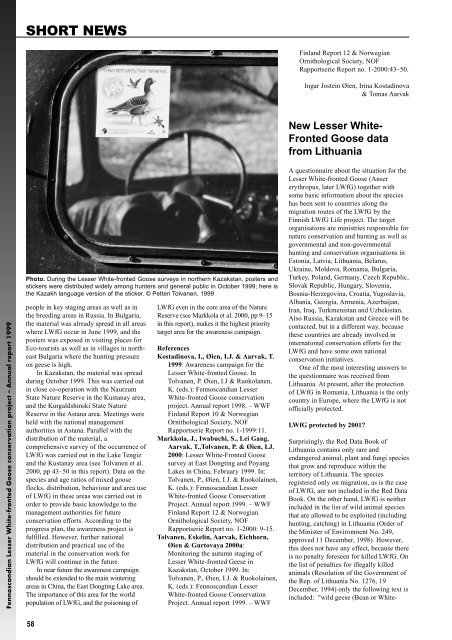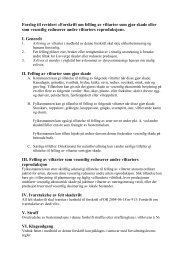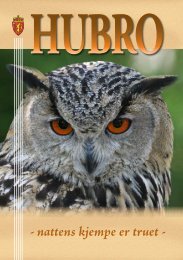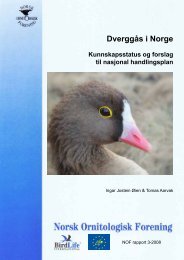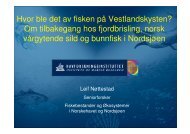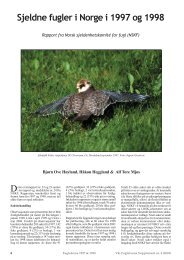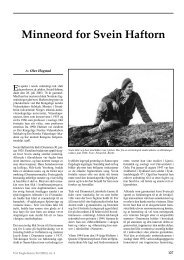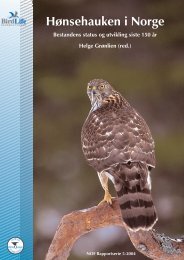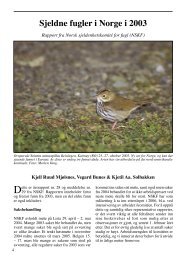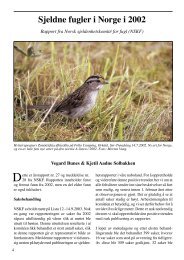Fennoscandian Lesser White-fronted Goose conservation project ...
Fennoscandian Lesser White-fronted Goose conservation project ...
Fennoscandian Lesser White-fronted Goose conservation project ...
You also want an ePaper? Increase the reach of your titles
YUMPU automatically turns print PDFs into web optimized ePapers that Google loves.
<strong>Fennoscandian</strong> <strong>Lesser</strong> <strong>White</strong>-<strong>fronted</strong> <strong>Goose</strong> <strong>conservation</strong> <strong>project</strong> – Annual report 1999<br />
SHORT NEWS<br />
Photo. During the <strong>Lesser</strong> <strong>White</strong>-<strong>fronted</strong> <strong>Goose</strong> surveys in northern Kazakstan, posters and<br />
stickers were distributed widely among hunters and general public in October 1999; here is<br />
the Kazakh language version of the sticker. © Petteri Tolvanen, 1999<br />
people in key staging areas as well as in<br />
the breeding areas in Russia. In Bulgaria,<br />
the material was already spread in all areas<br />
where LWfG occur in June 1999, and the<br />
posters was exposed in visiting places for<br />
Eco-tourists as well as in villages in northeast<br />
Bulgaria where the hunting pressure<br />
on geese is high.<br />
In Kazakstan, the material was spread<br />
during October 1999. This was carried out<br />
in close co-operation with the Naurzum<br />
State Nature Reserve in the Kustanay area,<br />
and the Kurgaldshinski State Nature<br />
Reserve in the Astana area. Meetings were<br />
held with the national management<br />
authorities in Astana. Parallel with the<br />
distribution of the material, a<br />
comprehensive survey of the occurrence of<br />
LWfG was carried out in the Lake Tengiz<br />
and the Kustanay area (see Tolvanen et al.<br />
2000, pp 43–50 in this report). Data on the<br />
species and age ratios of mixed goose<br />
flocks, distribution, behaviour and area use<br />
of LWfG in these areas was carried out in<br />
order to provide basic knowledge to the<br />
management authorities for future<br />
<strong>conservation</strong> efforts. According to the<br />
progress plan, the awareness <strong>project</strong> is<br />
fulfilled. However, further national<br />
distribution and practical use of the<br />
material in the <strong>conservation</strong> work for<br />
LWfG will continue in the future.<br />
In near future the awareness campaign<br />
should be extended to the main wintering<br />
areas in China, the East Dongting Lake area.<br />
The importance of this area for the world<br />
population of LWfG, and the poisoning of<br />
58<br />
LWfG even in the core area of the Nature<br />
Reserve (see Markkola et al. 2000, pp 9–15<br />
in this report), makes it the highest priority<br />
target area for the awareness campaign.<br />
References<br />
Kostadinova, I., Øien, I.J. & Aarvak, T.<br />
1999: Awareness campaign for the<br />
<strong>Lesser</strong> <strong>White</strong>-<strong>fronted</strong> <strong>Goose</strong>. In<br />
Tolvanen, P. Øien, I.J & Ruokolanen,<br />
K. (eds.): <strong>Fennoscandian</strong> <strong>Lesser</strong><br />
<strong>White</strong>-<strong>fronted</strong> <strong>Goose</strong> <strong>conservation</strong><br />
<strong>project</strong>. Annual report 1998. – WWF<br />
Finland Report 10 & Norwegian<br />
Ornithological Society, NOF<br />
Rapportserie Report no. 1-1999:11.<br />
Markkola, J., Iwabuchi, S., Lei Gang,<br />
Aarvak, T.,Tolvanen, P. & Øien, I.J.<br />
2000: <strong>Lesser</strong> <strong>White</strong>-Fronted <strong>Goose</strong><br />
survey at East Dongting and Poyang<br />
Lakes in China, February 1999. In:<br />
Tolvanen, P., Øien, I.J. & Ruokolainen,<br />
K. (eds.): <strong>Fennoscandian</strong> <strong>Lesser</strong><br />
<strong>White</strong>-<strong>fronted</strong> <strong>Goose</strong> Conservation<br />
Project. Annual report 1999. – WWF<br />
Finland Report 12 & Norwegian<br />
Ornithological Society, NOF<br />
Rapportserie Report no. 1-2000: 9-15.<br />
Tolvanen, Eskelin, Aarvak, Eichhorn,<br />
Øien & Gurtovaya 2000a:<br />
Monitoring the autumn staging of<br />
<strong>Lesser</strong> <strong>White</strong>-<strong>fronted</strong> Geese in<br />
Kazakstan, October 1999. In:<br />
Tolvanen, P., Øien, I.J. & Ruokolainen,<br />
K. (eds.): <strong>Fennoscandian</strong> <strong>Lesser</strong><br />
<strong>White</strong>-<strong>fronted</strong> <strong>Goose</strong> Conservation<br />
Project. Annual report 1999. – WWF<br />
Finland Report 12 & Norwegian<br />
Ornithological Society, NOF<br />
Rapportserie Report no. 1-2000:43–50.<br />
Ingar Jostein Øien, Irina Kostadinova<br />
& Tomas Aarvak<br />
New <strong>Lesser</strong> <strong>White</strong>-<br />
Fronted <strong>Goose</strong> data<br />
from Lithuania<br />
A questionnaire about the situation for the<br />
<strong>Lesser</strong> <strong>White</strong>-<strong>fronted</strong> <strong>Goose</strong> (Anser<br />
erythropus, later LWfG) together with<br />
some basic information about the species<br />
has been sent to countries along the<br />
migration routes of the LWfG by the<br />
Finnish LWfG Life <strong>project</strong>. The target<br />
organisations are ministries responsible for<br />
nature <strong>conservation</strong> and hunting as well as<br />
governmental and non-governmental<br />
hunting and <strong>conservation</strong> organisations in<br />
Estonia, Latvia, Lithuania, Belarus,<br />
Ukraine, Moldova, Romania, Bulgaria,<br />
Turkey, Poland, Germany, Czech Republic,<br />
Slovak Republic, Hungary, Slovenia,<br />
Bosnia-Herzegovina, Croatia, Yugoslavia,<br />
Albania, Georgia, Armenia, Azerbaijan,<br />
Iran, Iraq, Turkmenistan and Uzbekistan.<br />
Also Russia, Kazakstan and Greece will be<br />
contacted, but in a different way, because<br />
these countries are already involved in<br />
international <strong>conservation</strong> efforts for the<br />
LWfG and have some own national<br />
<strong>conservation</strong> initiatives.<br />
One of the most interesting answers to<br />
the questionnaire was received from<br />
Lithuania. At present, after the protection<br />
of LWfG in Romania, Lithuania is the only<br />
country in Europe, where the LWfG is not<br />
officially protected.<br />
LWfG protected by 2001?<br />
Surprisingly, the Red Data Book of<br />
Lithuania contains only rare and<br />
endangered animal, plant and fungi species<br />
that grow and reproduce within the<br />
territory of Lithuania. The species<br />
registered only on migration, as is the case<br />
of LWfG, are not included in the Red Data<br />
Book. On the other hand, LWfG is neither<br />
included in the list of wild animal species<br />
that are allowed to be exploited (including<br />
hunting, catching) in Lithuania (Order of<br />
the Minister of Environment No. 249,<br />
approved 11 December, 1998). However,<br />
this does not have any effect, because there<br />
is no penalty foreseen for killed LWfG. On<br />
the list of penalties for illegally killed<br />
animals (Resolution of the Government of<br />
the Rep. of Lithuania No. 1276, 19<br />
December, 1994) only the following text is<br />
included: "wild geese (Bean or <strong>White</strong>-


